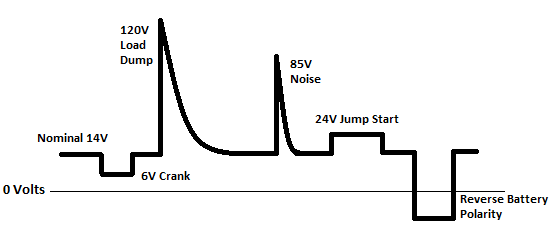-
Transients in 24V Automobiles SSZT783 february 2018 TLIN2022-Q1 , TLIN2029-Q1 , TLIN2441-Q1
-
Transients in 24V Automobiles
Transients in 24V Automobiles
Jonathan R. Claypool
Automobiles are becoming more advanced every day. The number of integrated circuits (ICs) is increasing every year and spreading to more modules within the automobile to control lights, heating, sensors and more. The new paradigm of designing automobiles with more features and electrical controls raises the question of whether this is safe, and whether ICs can withstand the voltage transients common in automotive environments.
Of course, if you apply a 12V power supply to a microcontroller requiring a 3.3V supply, the device will not operate correctly and you run the risk of catastrophic failure. The same principle applies to transients in the automotive environment, whose voltages can rise (or become negative) far beyond the specifications of the ICs. Transients are even more severe in 24V-battery systems like commercial trucks, forklifts and mass transit vehicles.
Nearly every car in the world uses the Local Interconnect Network (LIN) protocol. Modules that use LIN connect directly to the car battery through a diode; LIN transceivers that send and receive data across the LIN bus experience transients all the time. It is vital that you choose a LIN transceiver that is sufficiently protected from transients so that different modules in the car can communicate effectively. Figure 1 shows the most common automobile transients.
 Figure 1 Common Automobile
Transients
Figure 1 Common Automobile
TransientsAt the top of the dangerous transients list is the load dump, also known as a battery disconnect from the alternator. The alternator (the voltage source) is delivering charging current to the battery (the load). Due to the large inductance in the alternator and the drastic change in load current due to the battery being disconnected from the system in a short amount of time, there is a large voltage spike that all the remaining nodes connected to the alternator will see (V = L*di/dt). These voltage spikes can range anywhere from 25V to 120V, as shown in Figure 1. While this is a relatively short transient (milliseconds), some transients can last for several minutes.
Jump-starting a car is something most drivers have experienced. Jump-starts can be detrimental to ICs and electrical devices inside. The voltage regulators are intending to step down or step up automobiles supplied with a 12V battery (or a 24V battery in commercial vehicles). Roadside service vehicles typically use 24V batteries (or 48V batteries for commercial vehicles) to jump-start cars; this means your car is receiving two times the expected voltage. Electronic devices in the car may be exposed to this transient for up to five minutes as the jump-start procedure concludes.
The new TLIN family of LIN transceivers has robust performance in both 12V consumer and 24V (or higher) commercial vehicles. You can directly connect ICs to the system battery and provide communication between all modules in the car. They are built to withstand transients (load dumps), have a wide operating range (for jump-starts) and include DC fault protection (for reverse-battery) while increasing the speed and reliability of the LIN bus. Check out the TLIN2029-Q1 to learn more about 24V application capabilities.
Additional Resources
- Learn more about LIN and how it solves problems in automobiles in this blog, “LIN – The Last Mile Network”
- To see how LIN technology can be incorporated into today's vehicles, check out this 360 tour.
- For advanced knowledge on the electrical characteristic of LIN, check out this TI application note.
IMPORTANT NOTICE AND DISCLAIMER
TI PROVIDES TECHNICAL AND RELIABILITY DATA (INCLUDING DATASHEETS), DESIGN RESOURCES (INCLUDING REFERENCE DESIGNS), APPLICATION OR OTHER DESIGN ADVICE, WEB TOOLS, SAFETY INFORMATION, AND OTHER RESOURCES “AS IS” AND WITH ALL FAULTS, AND DISCLAIMS ALL WARRANTIES, EXPRESS AND IMPLIED, INCLUDING WITHOUT LIMITATION ANY IMPLIED WARRANTIES OF MERCHANTABILITY, FITNESS FOR A PARTICULAR PURPOSE OR NON-INFRINGEMENT OF THIRD PARTY INTELLECTUAL PROPERTY RIGHTS.
These resources are intended for skilled developers designing with TI products. You are solely responsible for (1) selecting the appropriate TI products for your application, (2) designing, validating and testing your application, and (3) ensuring your application meets applicable standards, and any other safety, security, or other requirements. These resources are subject to change without notice. TI grants you permission to use these resources only for development of an application that uses the TI products described in the resource. Other reproduction and display of these resources is prohibited. No license is granted to any other TI intellectual property right or to any third party intellectual property right. TI disclaims responsibility for, and you will fully indemnify TI and its representatives against, any claims, damages, costs, losses, and liabilities arising out of your use of these resources.
TI’s products are provided subject to TI’s Terms of Sale (www.ti.com/legal/termsofsale.html) or other applicable terms available either on ti.com or provided in conjunction with such TI products. TI’s provision of these resources does not expand or otherwise alter TI’s applicable warranties or warranty disclaimers for TI products.
Mailing Address: Texas Instruments, Post Office Box 655303, Dallas, Texas 75265
Copyright © 2023, Texas Instruments Incorporated